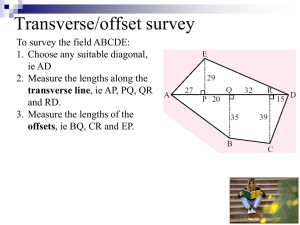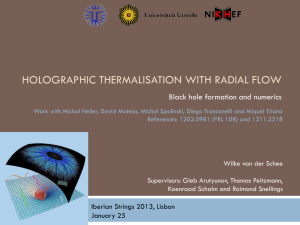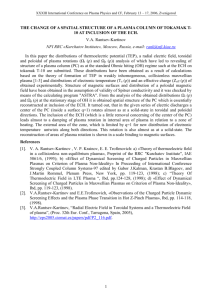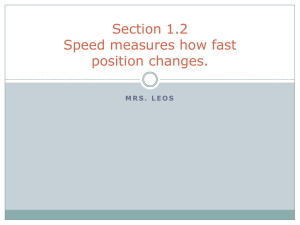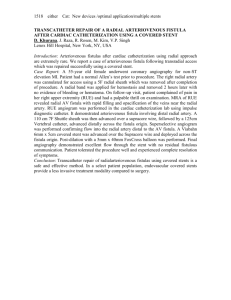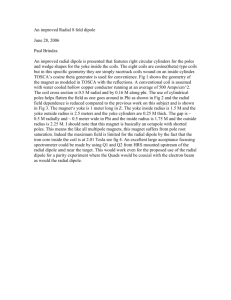Chapter 6
advertisement
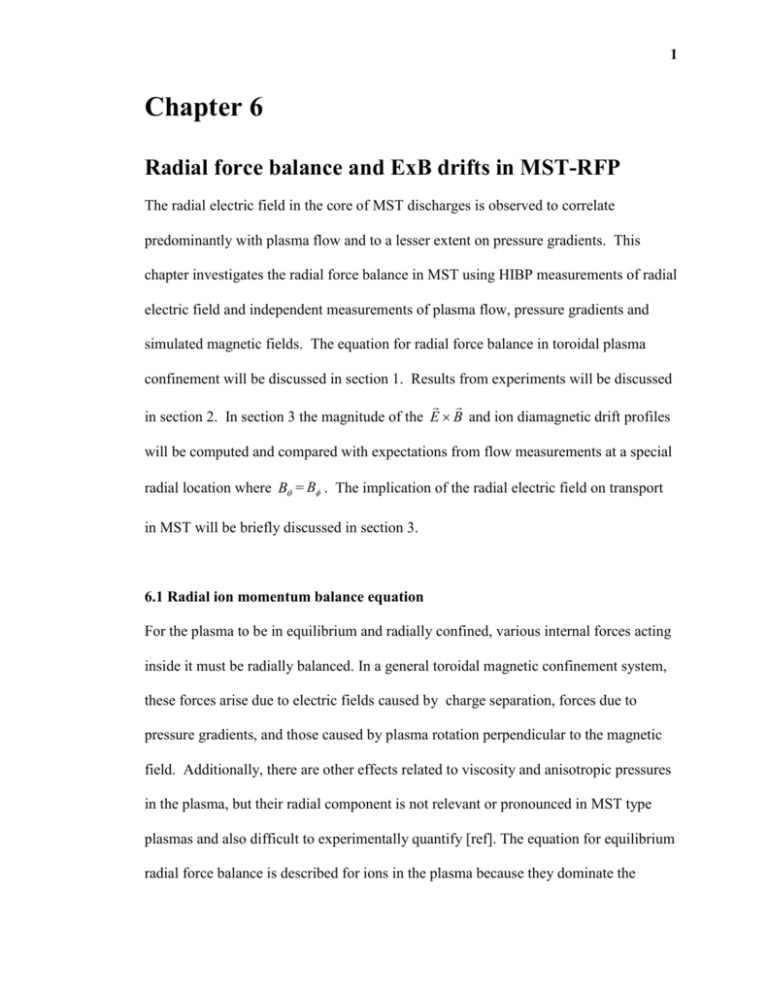
1 Chapter 6 Radial force balance and ExB drifts in MST-RFP The radial electric field in the core of MST discharges is observed to correlate predominantly with plasma flow and to a lesser extent on pressure gradients. This chapter investigates the radial force balance in MST using HIBP measurements of radial electric field and independent measurements of plasma flow, pressure gradients and simulated magnetic fields. The equation for radial force balance in toroidal plasma confinement will be discussed in section 1. Results from experiments will be discussed in section 2. In section 3 the magnitude of the E B and ion diamagnetic drift profiles will be computed and compared with expectations from flow measurements at a special radial location where B = B . The implication of the radial electric field on transport in MST will be briefly discussed in section 3. 6.1 Radial ion momentum balance equation For the plasma to be in equilibrium and radially confined, various internal forces acting inside it must be radially balanced. In a general toroidal magnetic confinement system, these forces arise due to electric fields caused by charge separation, forces due to pressure gradients, and those caused by plasma rotation perpendicular to the magnetic field. Additionally, there are other effects related to viscosity and anisotropic pressures in the plasma, but their radial component is not relevant or pronounced in MST type plasmas and also difficult to experimentally quantify [ref]. The equation for equilibrium radial force balance is described for ions in the plasma because they dominate the 2 plasma momentum (by virtue of their mass). The general relation that describes the equilibrium force balance of the ion species in the plasma is given by the following equation [ref]: Er 1 pi v B v B Z i en i r (1) where the quantities p i , v , v , ni represent the ion pressure gradient, toroidal and poloidal flow velocities of the ion species and ion density, respectively. B and B refer to the poloidal and toroidal components of the magnetic fields. The ion momentum equation is obtained by computing a second order moment of the Boltzman equation [ref] and solving for the radial component. The resulting moment equation is described by: u m n [ u .u ] q n [ E u B] p R t (2) where, = electrons or ions u = flow velocity p = total pressure tensor R = mean momentum transfer between unlike particles due to friction of collisions. In equilibrium, the first term of the left hand side becomes 0, the second term reduces to 0 for incompressible plasma flows. On the right hand side; the pressure tensor consists of an isotropic pressure gradient term and and an anisotropic pressure term which is related to the viscosity of the fluid. Only the isotropic pressure gradient 3 is considered in this case. Equation (1) represents the equilibrium radial force balance equation arising from these considerations. For the comparison discussed in this chapter, the radial electric field on the left of equation (1) is measured directly by the HIBP, while the terms on the right are measured independently. (Please refer to chapter 3 for list of diagnostics and measured quantities). The magnetic fields are computed from simulations. 6.2 Experimental results The HIBP measurements of E r can be directly compared to results obtained from independent measurements of the terms contained in the right hand side of the radial force balance equation (1). It is found that the ion momentum balance relation is generally satisfied in low and high current standard discharges within experimental uncertainty. In locked and biased plasmas, the results are not as conclusive because of the lack of ion temperature gradients (locked and biased) and electron density profiles (locked). However, in these cases certain approximations have been used to obtain results that also show agreement with radial force balance. In principle the radial force balance must be investigated for a given plasma species, be it ions or impurity. However, in practice the lack of available diagnostics to measure all of the quantities needed in equation (1) has made this task difficult on MST. Table 1 below summarizes the quantities used to investigate the ion momentum balance in the various discharges discussed in this section. The assumptions used to validate the 4 use of parameters of species other than ions will be discussed at the end of the results sections. Velocity 276 kA Std. Impurity flow 276 kA locked Impurity flow 276 kA Biased Impurity flow Density ne ne ne Temperature Ti 383 kA Std. m=1, n=6-15 mode velocity ne Te (standard Te Ti profile) Table 1. Parameters used to compute the right hand terms of equilibrium radial force balance equation (1). 6.2.1 Low current standard discharge The terms contained in equation 1 are plotted in figure 1. The sum of the pressure gradient and the v B terms1 is also plotted in the figure for comparative purposes. The agreement between the HIBP measurements and the right hand side quantities is very good in the radial range of r = 16-27 cm (core). The v B term dominates over the pressure gradient contribution in the core by 3-6 times. At r> 26 cm the discrepancy between the HIBP measurement and the computed electric field becomes fairly large (~500V/m). In this region the pressure gradient approaches is also significant and represents roughly 50% of the magnitude of v B . 1 Referred to the rest of the chapter as computed electric field, as opposed to the HIBP measured electric field. 5 4000 3000 -v x B V/m 2000 1/qn[grad(P)] 1000 -(v x B)+1/qn[grad(P)] 0 -1000 0 10 20 30 40 HIBP -2000 Minor Radius (cm) Figure 1. Plots of the quantities in the radial force balance. The sum of the computed terms is also shown. Measured ion and electron temperature profiles in 276 kA standard discharges are shown in figure 2. The uncertainty in the temperature measurements dominates the uncertainty in the pressure profiles. As is characteristic in standard plasma discharges, the electron and the ion temperatures are very similar at low currents at times far away from the sawtooth crash[ref]. The discrepancy in these two quantities starts to become more pronounced at the sawtooth crash where anomalous ion heating effects cause the ion temperature to rise by up by 50% [ref]. Temperature (eV) 250 200 T_i T_e 150 100 0 20 40 Minor Radius (cm) Figure 2. Ion and electron temperature profile in a 276 kA standard discharge 6 A typical density profile from a 276 kA standard discharge at approximately midway through the sawtooth cycle is shown in figure 3. The relatively weak density gradient (500 V/m) for r < 23 cm is suggestive of the fact that the electrons are not well confined in this region and that stochastic loss processes transport them out of the core [ref]. The electric field at r ~ 22 cm is also the highest over the measurement range (1631 cm) which is consistent with the formation of an ambipolar radial electric field which tries to hold back the transport of mobile electrons. The higher resultant electric field is also related to toroidal plasma rotation. Figure 3. Typical electron density profile in a 276 kA standard discharge 7 Figure 4. Toroidal and poloidal velocities of C+IV emission lines Time traces of typical toroidal and poloidal flow velocities used in the computation are shown in figure 4. The typical toroidal to poloidal flow velocity ratio in MST is 5-7 in a low current standard discharge [ref]. This is also the case in discharge shown where the average toroidal velocity between sawtooth crashes is approximately 22 km/s and the average poloidal flow velocity ranges from 3-5 km/s. The toroidal flow in the discharges used to obtain the average electric field ranged from 20-25 km/s. The neoclassical effect causing a zero toroidal rotation in the core, as observed in Tokamaks [ref] is contrasted in MST which is dominated by a very large toroidal flow that is oppositely directed to the direction of the toroidal magnetic field. As the analysis conducted in section 3 shows, the large component of the flow in MST is attributed to a component that is parallel to the magnetic field. The subject of parallel flow generation has not been investigated in much detail in the RFP and little is known at present on this subject [ref]. In a strict sense, calculation of the v B term in the radial force balance requires measurements of toroidal and poloidal flow profiles. However, the IDS spectrometer [ref] makes a chord averaged measurement of the toroidal and poloidal flow over a region spanning ~15 cm. For these investigations the flow velocity was averaged over a radial range spanning r = 17 to 30 cm, however, the confidence in the measurement location spans 17 to 25 cm [ref]. Hence, calculations have been performed using a constant value of toroidal and poloidal flow velocities which are uncertain to within 10% [ref]. 8 While the radial force balance is shown to agree with measurements for r <25 cm, the discrepancy outside this radial location arises from the lack of well resolved measurements of flow velocity profiles, uncertainties in pressure gradients and in the measurement of E r itself. The dominant contribution to E r in the right hand side of the radial force balance stems from the v B term. For r>23 cm v B >> v B , because v >> v and B >> B . Hence, the v B rises monotonically when a constant velocity profile is used. However, in reality the velocity profiles are not constant. In fact the toroidal flow velocity measurements show that its magnitude tends to decrease in the vicinity of the reversal surface (r ~ 43 cm) [ref]. Thus, higher than actual values of flow velocity over the region r>25 cm can help explain the overcompensation of the v B term to the overall radial force balance. Quantitatively a change of 20% in the flow in this region can reduce the v B contribution by ~760V/m; enough to establish an overall agreement between the HIBP measurements and the computed electric field. The second source of uncertainty in the measurement comes from the contribution of the pressure gradient. While the density gradient is uncertain to less than 3% [ref], the ion-temperature measurements are subject to large uncertainties of almost XXX % [ref]. The uncertainty in the gradient in Ti is larger due to lack of spatial resolution. Quantitatively the uncertainty in the Ti term is estimated to be on the order of 500 V/m at r ~25-33 cm. Finally, the uncertainty in the HIBP measurement of the electric field is also in the order of 700 V/m. 6.2.3. Locked discharges 9 The HIBP measurement of potential profile in locked discharges is shown in figure 5. As discussed in chapter 4, the decrease in plasma potential is highly correlated with the change in the n=6 phase velocity, which as shown below is correlated with toroidal plasma rotation. A decrease in the plasma potential of approximately 600V between standard and locked plasmas is also typical at high plasma currents [chapter 4]. For the purpose of radial force balance investigation, the electric field as computed from HIBP measurements is inferred to be zero from the potential profile shown in figure5. kV Potential Profile in a Low Current Locked Discharge 0.8 0.7 0.6 0.5 0.4 0.3 0.2 0.1 0 0 0.1 0.2 0.3 0.4 0.5 0.6 0.7 r/a Figure 5. Potential profile in a low current locked discharge P The v B and terms in the force balance are plotted in figure 6. However, the qn calculations utilize a pressure profile obtained in standard discharges. Using this assumption, the resultant electric field is on the order of –400V/m in the radial range of 17-25 cm. The calculated electric field profile is also relatively flat in this region but increases for r >25 cm to around –600V/m. 10 1500 E_r (V/m) 1000 500 0 -500 0 10 20 30 40 -(vxB) -1000 T_i/n[grad(n)] -1500 -(vxB)+1/qn[grad(P)] -2000 Major Radius Figure 6. Values of terms contained in radial force balance. The sum of the v B andpressure gradient term is also shown. E r measured with HIBP is not shown. What directly impacts the changes in the electric fields in the locked discharge are the changes in the v B force compared to a standard discharge (seen by comparing figures 1 and 6). Time traces of toroidal and poloidal flow velocities in a typical locked discharge are shown in figure 7. The typical toroidal and poloidal velocities range from 7-8km/s and 5-7 km/s respectively. Figure 7. Time traces of toroidal and poloidal flow velocity of C-V impurity species in the core. The abrupt decrease in the magnitude of the toroidal flow and the relatively constant value over the remainder of the discharge are hallmarks of locked MST 11 discharges. In this particular example, the toroidal flow was on the order of 19 km/s before the sawtooth crash at 12.98 ms. After the crash, it can reach speeds of ~8 km/s. The poloidal flow increases to a value of up to 7.5 km/s after locking from a previously lower average value (~5 km/s). The relatively equal magnitudes of the toroidal and poloidal magnetic fields and flow causes the v B generated E r to be on the order of 0250 V/m over a limited radial range (r =18-22 cm). For r > 22 cm the poloidal field magnitude dominates the v B contribution although the maximum value is limited to 1000 V/m over the measurement range depicted in figure 6 (shown above). It is expected that for r > 25 cm the v B term over compensates the radial force balance for the same reason discussed earlier. A measurement of the flow velocity profile will greatly enhance the confidence of this comparison. Another reason for the possible discrepancy between the electric field measurements inferred from HIBP and the radial force balance is due to the use of a plasma pressure profile obtained in the standard discharge. Pressure profiles in the locked plasmas were also unavailable and the overall uncertainty will be affected by uncertainty in density as well as in temperature gradients. Furthermore, a difference in the absolute temperature affects the Ti ne term as well. en e r A quantification of the impact of using Ti profile from a standard discharge in the study has been performed on the basis of some valid experimental evidence. This analysis uses a result that is established in high current discharges, namely: the quantitative and qualitatively similar values of impurity temperature( Timpurity ) made by 12 IDS and Ti measured using the Rutherford scattering in the core of a 380 kA standard discharge [ref]. These two quantities are plotted in the figure 8 [ref]. Figure 8. Temperarture measurements: (solid line) impurity ion temperature , (dark diamonds) ion temperature, (triangles) electron temperature centered about a sawtooth crash. The temperature shown in figure 8 is time referenced to a sawtooth crash (zero refers to the instant of the crash). At times far away from the crash, the Rutherford scattering measurement of the bulk ion temperature lies almost exactly on top of the IDS measurement. IDS measurement of Timpurity for a typical locked discharge is plotted in figure 9. If the similarity between Ti and Timpurity is were to hold in locked cases, then the IDS measurement would suggest that Ti is on the order of 150 eV away from a crash. Figure 9. IDS measurement of impurity ion temperature 13 When using Ti ~ 150 eV, the Ti ne term is 30% lower than in a standard en e r discharge (for r~18-25 cm). Quantitatively over the same range, this increases the computed electric field shown in figure 6 by +160 - 330 V/m, making the resultant electric field even closer to the E r inferred from HIBP measurements. This simpleminded analysis neglects the changes in the density gradient. However, the density gradient is not expected to be steeper in this region because locked shots are associated with even poorer levels of plasma confinement [ref]. The changes in the computed values of radial electric field due to a change in the temperature gradient can not be quantified because the IDS measurement depicted in figure 9 can not provide a local measurement of impurity temperature. 6.2.4 Biased discharge The application of negative biasing has been observed to suppress electrostatic fluctuation induced transport at the edge of an RFP [ref]. Various theories suggest that this is a consequence of the formation of a transport barrier arising from a sharp gradient in the local radial electric field [ref]. However, what happens to the core electric field had not previously been investigated experimentally in an RFP plasma. Theoretically this also remains an open question. The HIBP measurement of the core potential profile shows that the electric field is very small if not zero in these cases. Measurements show that can be lower by as much as 800 V compared to a standard discharge or 200 V lower than locked dishcarges. Measurements of (r ) are reproduced figure 10 from results obtained in chapter 4. A zero electric field is inferred from HIBP measurements for the purpose of radial force balance investigation. 14 0.6 0.5 kV 0.4 0.3 0.2 0.1 0 0 0.1 0.2 0.3 0.4 0.5 0.6 0.7 r/a Figure 10. Potential profile in a low current biased plasma The results from the radial force balance investigation are plotted in figure 11. The v B contribution monotonically increases with minor radius similar to the two previous cases. The resulting computed electric field shows a change in the direction of the radial electric field at r~20 cm. The magnitude of the electric field is smaller by a factor of as much as 3-10 compared to the standard discharge over the entire measurement range. 800 600 (V/m) 400 200 -(vxB) 0 0 5 10 15 20 25 30 35 1/qn_e[grad(P)] -200 -(vxB)+1/qn_e[grad(P )] -400 -600 Minor Radius (cm) Figure 11. Radial force balance in a biased discharge. 15 As in the locked discharge, the v B contribution is significantly less compared to a standard discharge because of the predominantly large decrease of ~15 km/s in the toroidal rotation in a biased plasma. The overall contribution to the computed radial electric field due to v B ranges from –200 to -500 V/m for 17cm > r > 25 cm. The overall magnitude of the electric field as computed from the v B and 1 / qn[P ] terms lie in the range of –300 to +400 V/m. The electron temperature profile (obtained from multiple shot averaging) for an ne ~1.0 1013 / cm 3 biased discharge is shown in figure 12. The shape of the profile is similar to that in a standard discharge. 300 250 T (eV) 200 150 100 50 0 0 10 20 30 40 Minor Radius (cm) Figure 12. Electron temperature profile in a biased discharge. [ref] A typical density profile for a biased discharge during the middle of the sawtooth cycle is illustrated in figure 13. As remarked earlier, the rise in the central plasma density to 1x1013 / cm 3 is typical of biased plasmas. The core profile is fairly hollow and the density gradient in the region of present investigation is positive, in sharp contrast to the profiles in a standard discharge. However, the gradient becomes large and negative for r 16 > 35 cm. The combined effect of a positive density gradient and a negative electron temperature gradient causes the magnitude of the electric field computed from the sum of these two terms to be in the vicinity of 200 to 300 V/m for r < 27 cm. Figure 13. Density profile in a biased discharge. The toroidal and poloidal flow velocities are plotted in figure 14. The magnitude and behavior of toroidal flow is similar to flows in locked discharges (~7.5 km/s) but the poloidal flow is similar to those observed in standard discharges (3-5 km/s). No increase in the magnitude of the poloidal flow is observed when the plasma is biased as in the case of locking. However, when biasing is turned off, rotation in the toroidal direction begins to resume to its previous levels ( typically greater than 15 km/s). This is seen for t > 25 ms in the plot below: 17 Figure 14. Toroidal and poloidal rotation of impurity species in biased discharges. While the driving mechanism that causes the toroidal flow is different in locked and biased plasmas (discussed in chapter 3), the end result is similar in both. The toroidal rotation velocity is measured to be ~7-8 km in both cases. The effect of reducing the core rotation by over 65% (from 22 km/s to 7.5 km/s) in biased discharges is brought about through viscous coupling between the edge and the core plasma. The edge is observed to rotate in a negative direction with a large magnitude upon the application of biasing [ref]. Experimental evidence also shows that the change in rotation in the core lags changes at the edge possibly because of the finite time scale associated with viscous transfer of momentum, although no quantification has been done [ref]. The fact that a small or zero radial electric field is measured in biased discharges is consistent with the results obtained in locked discharges. This provides another verification that E r in MST is correlated with plasma flow. However, as discussed in section 4, the magnitude of the average potential is lower by ~250 V when compared to a locked discharge, which is also exhibited to have similar flow velocities. In chapter 4 it was established that was strongly correlated with the n=6 mode, phase rotation velocity ( v n 6 ) in high current standard discharges. Although not verified to the same extent, this result is also true at low currents. Since v n 6 v (discussed in section 6.2.6) this implies that v . Hence, these dissimilar potentials cannot be simply explained on the basis of measured changes of potential with flow ( or 18 n=6 mode phase rotation velocity - v n 6 ), because the toroidal rotation velocity is similar in locked and biased discharges. The difference in the density between the two plasmas was described as a possible reason for this difference. measurements were carried out in ne 0.6 0.8 x1013 / cm 3 locked plasmas versus ne ~ 1 1.2 x1013 / cm 3 biased discharges. However, an even more compelling reason may be due to the shape of the density profile in a biased discharge. As discussed above, the positive density gradient or a hollow profile (in the region of HIBP investigation) favours electron confinement which serves to decrease the plasma potential. The peak in the density profile occurs at ~ r~35 cm, inside which electrons are better confined. However, because B is still on the order of 1-1.4% in biased discharges [ref], magnetic fluctuation induced electron loss still prevents a large density gradient to be established for r < 30 cm, while enhanced confinement at the edge is contrasted by a sharp gradient in density for r >35cm. Furthermore, the fact that > +250V indicates that magnetic fluctuation induced electron loss is still the dominant transport mechanism in the core. While a decrease in electrostatic turbulence induced particle loss is reduced by a factor of XXX times in a biased discharge, the effect is limited to a 2-3 cm region surrounding the edge and is possibly attributed to a strong E B flow shear. No such measurements have been made in the core region. These facts suggest that the overall decrease in plasma potential in the core is attributed to relatively large plasma density, small toroidal rotation and a hollow density profile, while the small or negligible resultant electric field is strongly co-related with plasma plasma flow. However, the lack of a velocity profile suggests that the computed electric 19 field in the radial force balance can be uncertain by up to +400V/m in this region. Furthermore, because of uncertainties associated with replacing Ti with Te a more conclusive result awaits a measurement of Ti . 6.2.4 Experimental investigations in high currents2 Experimental investigation of the radial force balance has also been performed at high plasma currents, although the comparison has a greater level of uncertainty compared to those discussed above. This stems from the lack of toroidal and poloidal flow velocity measurements of impurity species. However, the phase velocity of the n=6-15 modes, along with estimates of poloidal velocity inside the reversal surface have been used in the analysis to obtain estimates of v B . The experimental measurement of E r did not coincide with the measurements of the ion-pressure gradients and phase velocities. The HIBP measurement was carried out in 383 kA standard discharges, while the latter quantities were obtained through averaging results obtained in over 400 discharges at 373 kA3 [ref]. The remaining plasma parameters were nearly identical in the two cases and are listed in table 4-XXX. (chapter 4). For the present discussion, the measured and the computed radial electric field will be focused at two time periods. These are: (a) 1.5-2.5 ms after a sawtooth (c) ~ 2-3 ms before a sawtooth crash. The results of these computations are shown in figures4 15. 2 The radial electric field was measured in 383 kA standard discharges, while the terms on the right hand side of the force balance were computed for 376 kA standard discharges. Computation of v B 1 / qn[P ] was carried out by Ted Biewer. Results are used here with his permission. 4 Figures provided by Ted Biewer 3 20 The HIBP measured average E r profiles are plotted in each figure 16. The agreement between the two results is, in general, very good. (a) (b) 2000 3000 2000 0 1000 -2000 0 -1000 -4000 -2000 -3000 -6000 0 10 20 30 40 0 50 10 20 30 40 50 Minor Radius (cm) Minor Radius (cm) Figure 15. Calculated radial electric field from v B 1 / qn[P] . (a) After sawtooth crash and (b) before crash. 3000 2500 V/m 2000 After 1500 Before 1000 500 0 0 10 20 30 40 Minor radius (cm) Figure 16. HIBP measurements of radial electric field before and after crash The magnitude of the calculated and the HIBP measured peak radial electric field (r~ 18 cm) is found to increase in general over the sawtooth cycle. One of the possible reasons is because of the lower average phase rotation of the n=6 modes after sawtooth crash. In general, the n=6 mode (resonant at r~10-20 cm), takes ~2-2.5 ms to accelerate to a peak value. Hence, the direct impact is to lower the magnitude of v B 21 which is found to be the dominant term. A plot of the n=6 mode phase velocity from a typical high current plasma discharge showing the lag in acceleration after a sawtooth crash is illustrated in figure 17. Sawtooth crashes occur at 15, 21.5 and 27.4 ms. Figure 17. n=6 mode phase velocity As mentioned earlier, the rotation velocity used in calculating E r utilizes phase velocities of modes n=7-15 whose resonant locations are computed from a safety factor profile [ref]. The poloidal rotation velocity used in these computations is based on measurements in low current standard discharges as well as on measurements of edge poloidal flow. An inverted parabolic flow velocity profile with constraints of zero poloidal flow at the core and at the very edge with a centrally peaked value of 5 km/s has been used for v [ref]. The fact that the n=6 mode velocity is used in the computation also explains why the evolution of the computed electric field shows a larger increase (800 V/m) over the sawtooth cycle compared to the HIBP value (400V/m). Experimental data shows that acceleration of the n=6 mode is typically slower than impurity species after a sawtooth crash (section 6.2.6). Hence, the measured radial electric field which is representative of the ion flow is higher than the computed field, because the dominance of the v B term in the computation causes the computed value to be lower. 22 The radial force balance comparison is discussed in this section for a number of reasons. First, it illustrates the capability of the HIBP to make a measurement of E r that agrees with theoretical predictions. The experimentally measured values of 2200 V/m – 2600 V/m over the sawtooth cycle agree with the estimates obtained from a direct calculation of ion momentum balance. Second, an experimental investigation surrounding particle transport in MST is presently being conducted [ref]. Part of the study involves estimating the magnitude of the radial electric field to determine whether the results are consistent with current theories associated with stochastic transport [ref]. Hence, results from a direct measurement of the time evolution of the average radial electric field can aid this study. 6.1.5 Justification for assumptions made in radial force balance computation 6.1.5.1 Magnetic fields The magnetic fields used in the study were obtained from MSTFit results (discussed in chapter 5.) The fields used in this analysis represent some of the most accurate available magnetic fields in MST [ref]. However, the overall uncertainty in the magnetic equilibrium is not less than 5%. At low currents, incorporating a 5% change in both components of the magnetic field yields a 170 V/m change in the maximum 23 v B contribution. However, a 10% change in the flow velocity combined with this changes this uncertainty to ~ 400V/m. 6.1.5.2 Impurity flow velocity While the ion momentum balance investigation requires an ion flow velocity measurement, the closest available measurement in MST is that of impurity flow. The ion dynamics spectrometer [ref] used for this purpose measures the velocity of C(+IV) impurity in the plasma, traces of which come from the small graphite bumper limiters in MST [ref]. The justification for the use of an impurity flow velocity in place of the majority species (ions) can be understood upon examination of the momentum and energy relaxation rates between the ions and the impurity species. A discussion of this is found in [ref]. The momentum relaxation time between the impurity and ion species in MST plasmas is estimated to range from 0.2-0.4 ms for 200-350 eV plasmas. The velocity equilibration times between the two species is less than 1 ms. From an experimental view point, the Doppler spectrometer has a time resolution of 250 kHz which is much greater than the relaxation rates. Furthermore, typical time traces of the flow velocity for the discharges considered here show a fairly uniform impurity flow over the time periods of 2-3 ms between successive sawtooth cycles. While there are fluctuations in the flow velocities, these quantities are averaged over the time period associated with equilibrium E r measurements. The uncertainty in the flow velocity measurement is on the order of 10% [ref]. However, for the present analysis, the larger uncertainty is in the lack of a spatial resolution of the measured flow for r > 25 cm. 24 6.1.5.3 Electron density Electron density has been substituted in place of an ion density in the computations. Using an assumption about charge neutrality and estimates of Z eff , a relation can be obtained that relates ion and electron densities in MST. The calculation assumes an ion, electron and carbon plasma. Other impurities like Al also exist but the density is computed to be much less than the plasma density obtained through a similar analysis [ref]. Using the following relation for Z eff [ref] and the estimated value in MST [ref] the following relation is obtained: n n 2 Z eff k (3) k k k ni 36nC 2 ni 6 nC (4) Assuming charge neutrality: ni 6nC ne or, nC ne ni 6 (5) Inserting equation 5 into 4 yields: ni 0.8ne (6) It turns out that the requirement for using the result from expression (6) does not arise because of the following argument: 25 1 / qn[Pi ] Ti ni Ti ne Ti Ti q qni q qne (7) 6.1.5.6 N=6 mode phase velocity In high current standard discharges it is found that the IDS measurement of the core plasma rotation is less reliable than at lower currents [ref]. Thus, to investigate the radial force balance in high current discharges requires a justifiable substitution of a quantity that is comparable to this flow. In MST, experimental evidence shows that the n=6 mode phase velocity is very similar to the IDS measurements of the impurity flow species at low currents [ref]. A plot of these two quantities for a single low current standard discharge is shown in figure 18. The most noticeable features are the deceleration during a sawtooth crash and sudden re-acceleration immediately following it. The investigations carried out at low currents show that there is an offset between the velocity of the two quantities which can be as large as 8 km/s. The n=6 mode phase velocity is typically higher than the impurity flow velocity. Interestingly, the level of this offset is maintained even at the crash. However, the impurities reach an equilibrium flow value over a quicker time scale (~ 1ms). Figure 18. Toroidal rotation of n=6 mode and impurity species. 26 Similar offset levels are also observed in locked and biased discharges at low currents. It is also experimentally observed that the n=6 mode phase velocity ranges from 15-40 km/s in both low and high current discharges. Though not conclusive these observations justify the use of n=6 mode velocity to approximate toroidal rotation at plasma currents high currents to obtain quantitative comparison. However, relatively large offsets of 7 km/s can cause a significant uncertainty in estimated v B magnitudes (~1.4 kV/m). 6.2. Particle drifts in MST plasma The notion of particles moving along a flux surface constrained by various forces has been identified to be important for confinement in toroidal devices. In general, these drifts force particles to lie in nested tori thereby causing them to be radially confined. Naturally this assumes that the magnetic field also lies in nested tori described by well defined flux surfaces – which do not always occur in MST. However, the establishment of a potential gradient shows that to the lowest order the particles do drift on various flux surfaces. The magnitudes of the perpendicular drifts, the magnitudes of the individual components will be discussed in this section. These results will be compared to the expectation of the total perpendicular drift based on measurements of the total plasma flow. The change in the magnitude of these drifts with changes in plasma current will also be discussed. Particle drifts perpendicular to a magnetic field in a toroidal confinement system are given by the following equation [ref]: 27 E B B P v B2 qnB 2 (8) The first term on the right hand side refers to charge independent E B drift while the second term refers to the particle drift caused by pressure gradients, more commonly known as a diamagnetic drift. Figure 19 illustrates the directions of the various drifts and magnetic fields in MST. Figure 19. Directions of various drifts in MST. The contributions from the E B and ion diamagnetic drifts computed using the HIBP measurement of the radial electric field and ion pressure gradients are shown in figure 20. The total perpendicular drift is also shown in the figure. 28 Velocity (km/s) Perpendicular Drifts 16 14 12 10 8 6 4 2 0 V_ExB V_Diamagnetic V_Total 0 10 20 30 40 Minor Radius (cm) Figure 20. Perpendicular drifts in a low current standard discharge computed from experimental results. The two drifts are found to be complementary. The E B drifts dominate in the core (r<25 cm) and the diamagnetic drifts begins to dominate for r>26 cm. The perpendicular drift ranges from 8-13 km/s over the measurement region. When broken down in terms of the individual components, the direction and magnitude of the component of these two drifts reveals a very interesting artifact: the direction of the flow opposes the total measured poloidal flow ( v ). This is also shown in figure 19. At r= 20.1 cm the poloidal component of the total perpendicular flow ( v , ) reaches a peak value of +8.6 km/s (from plot in figure 21). However, the measured value of v is ~ - 4.5 km/s in these standard discharges. Velocity(cm) 29 10 9 8 7 6 5 4 3 2 1 0 V_Diamagnetic V_ExB V_total 0 10 20 30 40 Minor Radius (km/s) Figure 21. component of perpendicular flow. The magnitude of the toroidal component of the total perpendicular flow ( v , ) is also 8.6 km/s, however, its direction is the same as the toroidal flow ( v ) measured in the plasma. This is plotted in figure 22. The magnitude of v in these discharges is ~22.5 km/s. 14 Velocity (km/s) 12 10 8 V_Diamagnetic 6 V_ExB 4 V_total 2 0 0 10 20 30 40 Minor Radius (cm) Figure 22. Toroidal or component of perpendicular flow The fact that the perpendicular drifts do not account for all of the measured poloidal flow in the RFP results because of the presence of a large component of the 30 total flow which is anti-parallel to the magnetic field5. In general, measurements of the v and v and magnetic field profiles can be used to determine the magnitude of the total perpendicular as well as parallel flow at any radial location. The details of the derivations will be discussed in appendix E. As a special case, consider the radial location where B = B (r =20.1 cm). The expressions for the parallel and perpendicular flow are given by: 1 v // 2 [v v ] (9) and v 1 2 v v (10) Using equation (10), the values of the perpendicular component of the total flow in MST (for this special case) can be estimated. This helps determine whether the total perpendicular drift is accounted for by the E B and diamagnetic drifts in MST. The table below summarizes the total and measured flows in the various discharges as well as the v // and v flows anticipated from equations (9) and (10) in the various low current discharges studied in this thesis. The measured perpendicular flow arising from E B and pressure gradients are given separately in the last row – the sum of the two contributions is in good agreement with the expected v obtained from calculations. 5 This is commonly referred to in MST literature as simply parallel flow. The term anti-parallel refers to the fact that the direction of this flow is opposite to the direction of MST. 31 v (km/s) Standard 22.5 Locked 7 Biased 4.3 v (km/s) 4.5 7.8 6.3 v // (km/s) 19.1 10.47 7.6 v (km/s) v E B (km/s) 12.6 9.4 0.5 ~0 1.4 ~0 vP 2.62 not measured not measured Table 2. Quantification of various velocities in MST for low current standard, locked and biased discharges. The ion pressure gradient was not measured in locked or biased discharges These calculations show that in standard discharges, the measured pressure profiles and radial electric field can account for nearly all the perpendicular component of the plasma flow inferred from toroidal and poloidal flow measurements. In locked and biased discharges, measurements show that in the presence of vanishingly small E B drifts, the perpendicular component of the expected flow is also very small. The iondiamagnetic drifts are not accounted for in this analysis in the locked and biased discharges and await further measurements. However, the pressure gradients in a locked discharge are not expected to become any larger compared to a standard discharge for reasons discussed in section 6.2. Hence, the diamagnetic contribution should be small and in agreement with the expectation. In biased discharges, the density profiles are hollow, but the ion temperature gradients have not been measured. If Ti (r) ~ Te (r), then the expected diamagnetic drift should be small in this case as well. 6.4 Radial electric field and transport 32 The measurement of the radial electric field in MST has been motivated by the implications it may have on particle transport. In general there is a dearth of theoretical work which can help relate the radial electric field and transport inside the core of a stochastic system such as MST. However, various theories linking the shear in the radial electric field with suppression of electrostatic turbulence induced transport at the edge have been experimentally supported [ref]. This section briefly discusses the implication of the first ever direct measurements of the radial electric field in the core of a hot rotating plasma on a particularly well discussed theoretical work. The specific example discusses the relation between the particle and heat flux, and the ambipolar electric field in the presence of a stochastic magnetic field [ref]. The ambipolar electric field in this formalism is of the form given by: E Te e 1 ne 1 Te ne r 2Te r (11) A comparison has been made with the results obtained using equation (11) with the measured E r obtained from HIBP. This resultant electric field from this calculation is plotted in figure 23. 33 3000 2000 1000 0 -1000 -2000 -3000 0 10 20 30 40 50 Minor Radius (cm) Figure 23. Radial electric field computed using equation 11 (the one that starts at 0 and rises) – please ignore the other one for the moment. I will get rid of it in the final version. The two results are in disagreement. Because of the relatively small gradients in temperature and density, the electric field as given by this expression is smaller by up to an order of magnitude compared to the measured electric field in the core of MST. The fundamental reason for the disagreement is the fact that profiles of plasma rotation are not taken into account in this theory. Despite being a stochastic system, one of the fundamental characteristics of MST plasma is its intrinsic rotation which is established to be stongly correlated with the radial electric field. Hence, any theory linking the radial electric field and transport in the core of a magnetic system with properties such as MST, should involve the concept of plasma rotation. 6.5 Summary The experimental investigation carried out to determine the relationship between plasma rotation and radial electric field has established a close relation between the two 34 quantities. It has been found that standard a plasma which rotates toroidally as well as poloidally can produce an electric field with magnitudes of up to 2 kV/m in the core in low current discharges. In standard discharges, it was also found that the effect of the pressure gradients on electric fields, although small (300-500V/m) for r<25 cm, is nonnegligible in the overall radial force balance. More importantly, P become very qn significant for r>27 cm, perhaps indicating that the dominant stochastic region lies half way inside the plasma. Experiments conducted in low current biased discharges show that the measured radial electric field is found to be small or close to zero in biased and locked discharges. Both discharges are found to have similar flow properties, albeit caused by different mechanisms, which suggests a connection between flow and electric field. The negative biased discharges were found to have slightly better electron confinement in the HIBP measurement region, however, no shear in the electric field was observed in the core. E r measurements in high current standard discharges showed strong support that v B was still the dominant term in the radial force balance. The apparent similarity between the n=6 mode velocity in the high and low current cases justified that the plasma flows should be similar at high and low currents. Additionally, that the pressure gradients were also similar in high and low currents justifies the fact that scaling of the radial electric field with current is indeed related to the v B force. A larger magnitude of the magnetic field in higher currents is responsible for the higher electric fields measured. 35 E B generated flows and diamagnetic drifts calculated account for the perpendicular component of the total plasma flow in MST. The fact that large parallel flows exist in MST also helped account for the apparent discrepancies in direction between E B and diamagnetic drifts and the measured poloidal flow. Finally, an attempt was made to compare the electric field results made by the HIBP to that obtained from theoretical expectations in a stochastic system. The results showed that the lack of inclusion of finite rotation in such a theory could be the major reason for the difference between the two results. It is hoped that the results HIBP experimental results of E r discussed in this section will inspire theoretical work linking the radial electric field and transport in the RFP.
